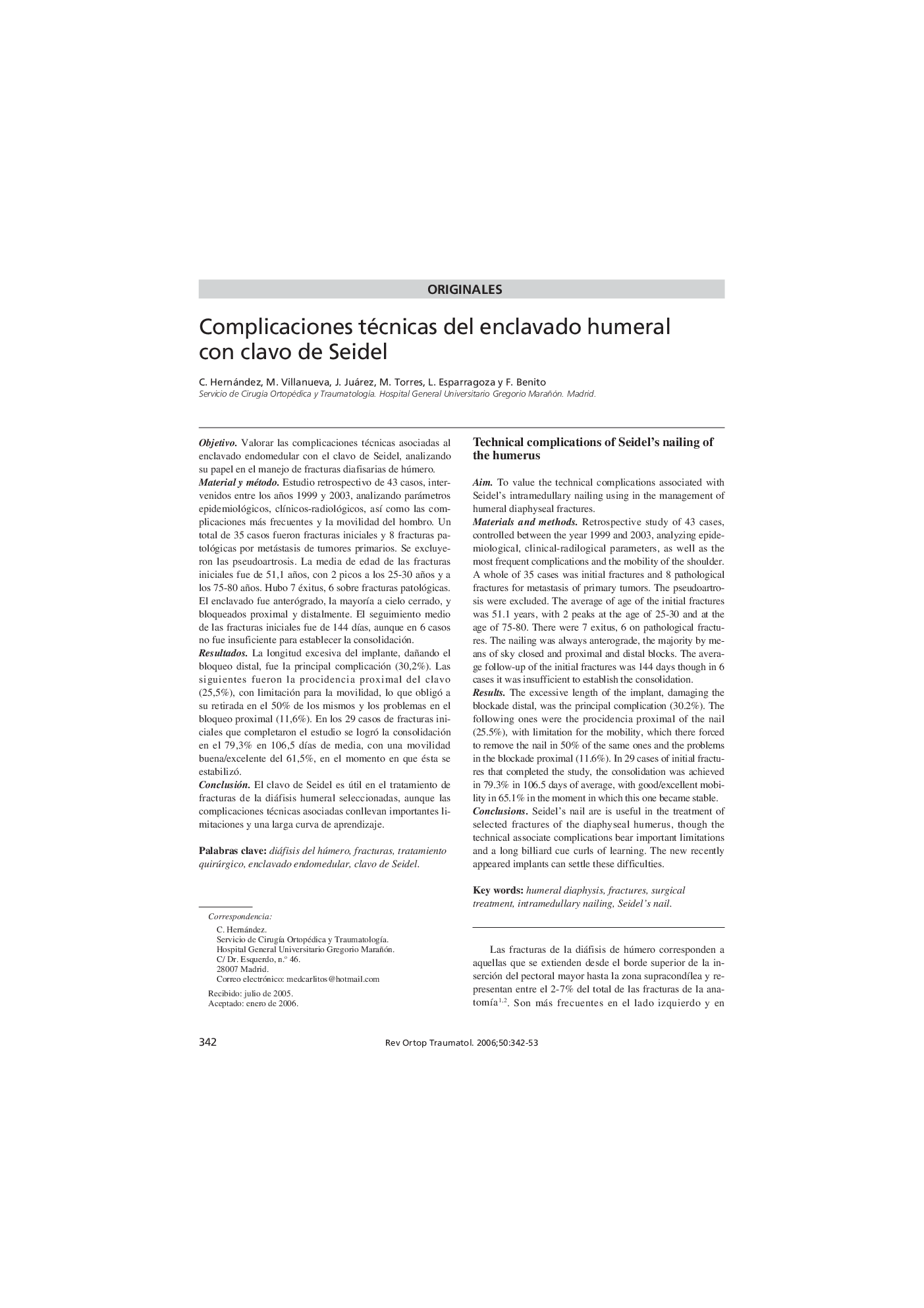| Article ID | Journal | Published Year | Pages | File Type |
|---|---|---|---|---|
| 4086993 | Revista Española de Cirugía Ortopédica y Traumatología | 2006 | 12 Pages |
ObjetivoValorar las complicaciones técnicas asociadas al enclavado endomedular con el clavo de Seidel, analizando su papel en el manejo de fracturas diafisarias de húmero.Material y métodoEstudio retrospectivo de 43 casos, intervenidos entre los años 1999 y 2003, analizando parámetros epidemiológicos, clínicos-radiológicos, así como las complicaciones más frecuentes y la movilidad del hombro. Un total de 35 casos fueron fracturas iniciales y 8 fracturas patológicas por metástasis de tumores primarios. Se excluyeron las pseudoartrosis. La media de edad de las fracturas iniciales fue de 51,1 años, con 2 picos a los 25-30 años y a los 75-80 años. Hubo 7 éxitus, 6 sobre fracturas patológicas. El enclavado fue anterógrado, la mayoría a cielo cerrado, y bloqueados proximal y distalmente. El seguimiento medio de las fracturas iniciales fue de 144 días, aunque en 6 casos no fue insuficiente para establecer la consolidación.ResultadosLa longitud excesiva del implante, dañando el bloqueo distal, fue la principal complicación (30,2%). Las siguientes fueron la procidencia proximal del clavo (25,5%), con limitación para la movilidad, lo que obligó a su retirada en el 50% de los mismos y los problemas en el bloqueo proximal (11,6%). En los 29 casos de fracturas iniciales que completaron el estudio se logró la consolidación en el 79,3% en 106,5 días de media, con una movilidad buena/excelente del 61,5%, en el momento en que ésta se estabilizó.ConclusiónEl clavo de Seidel es útil en el tratamiento de fracturas de la diáfisis humeral seleccionadas, aunque las complicaciones técnicas asociadas conllevan importantes limitaciones y una larga curva de aprendizaje.
AimTo value the technical complications associated with Seidel's intramedullary nailing using in the management of humeral diaphyseal fractures.Materials and methodsRetrospective study of 43 cases, controlled between the year 1999 and 2003, analyzing epidemiological, clinical-radilogical parameters, as well as the most frequent complications and the mobility of the shoulder. A whole of 35 cases was initial fractures and 8 pathological fractures for metastasis of primary tumors. The pseudoartrosis were excluded. The average of age of the initial fractures was 51.1 years, with 2 peaks at the age of 25-30 and at the age of 75-80. There were 7 exitus, 6 on pathological fractures. The nailing was always anterograde, the majority by means of sky closed and proximal and distal blocks. The average follow-up of the initial fractures was 144 days though in 6 cases it was insufficient to establish the consolidation.ResultsThe excessive length of the implant, damaging the blockade distal, was the principal complication (30.2%). The following ones were the procidencia proximal of the nail (25.5%), with limitation for the mobility, which there forced to remove the nail in 50% of the same ones and the problems in the blockade proximal (11.6%). In 29 cases of initial fractures that completed the study, the consolidation was achieved in 79.3% in 106.5 days of average, with good/excellent mobility in 65.1% in the moment in which this one became stable.ConclusionsSeidel's nail are is useful in the treatment of selected fractures of the diaphyseal humerus, though the technical associate complications bear important limitations and a long billiard cue curls of learning. The new recently appeared implants can settle these difficulties.
